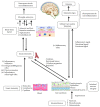Connection between Systemic Inflammation and Neuroinflammation Underlies Neuroprotective Mechanism of Several Phytochemicals in Neurodegenerative Diseases
- PMID: 30402203
- PMCID: PMC6196798
- DOI: 10.1155/2018/1972714
Connection between Systemic Inflammation and Neuroinflammation Underlies Neuroprotective Mechanism of Several Phytochemicals in Neurodegenerative Diseases
Abstract
Oxidative damage, mitochondrial dysfunction, and neuroinflammation are strongly implicated in the pathogenesis of neurodegenerative diseases including Alzheimer's disease (AD) and Parkinson's disease (PD), and a substantial portion of elderly population at risk of these diseases requires nutritional intervention to benefit health due to lack of clinically relevant drugs. To this end, anti-inflammatory mechanisms of several phytochemicals such as curcumin, resveratrol, propolis, polyunsaturated fatty acids (PUFAs), and ginsenosides have been extensively studied. However, correlation of the phytochemicals with neuroinflammation or brain nutrition is not fully considered, especially in their therapeutic mechanism for neuronal damage or dysfunction. In this article, we review the advance in antioxidative and anti-inflammatory effects of phytochemicals and discuss the potential communication with brain microenvironment by improved gastrointestinal function, enhanced systemic immunity, and neuroprotective outcomes. These data show that phytochemicals may modulate and suppress neuroinflammation of the brain by several approaches: (1) reducing systemic inflammation and infiltration via the blood-brain barrier (BBB), (2) direct permeation into the brain parenchyma leading to neuroprotection, (3) enhancing integrity of disrupted BBB, and (4) vagal reflex-mediated nutrition and protection by gastrointestinal function signaling to the brain. Therefore, many phytochemicals have multiple potential neuroprotective approaches contributing to therapeutic benefit for pathogenesis of neurodegenerative diseases, and development of strategies for preventing these diseases represents a considerable public health concern and socioeconomic burden.
Figures


References
Publication types
MeSH terms
Substances
Grants and funding
LinkOut - more resources
Full Text Sources
Medical
Molecular Biology Databases

